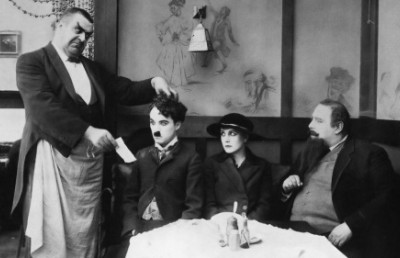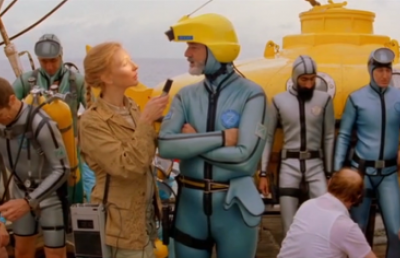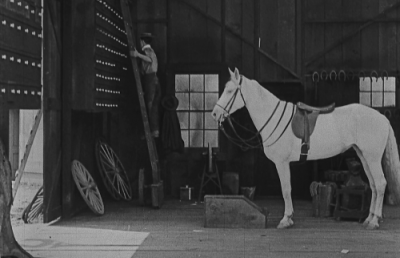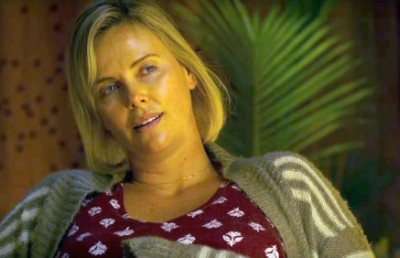Stranger Than Paradise: Comedy ‘Noir’
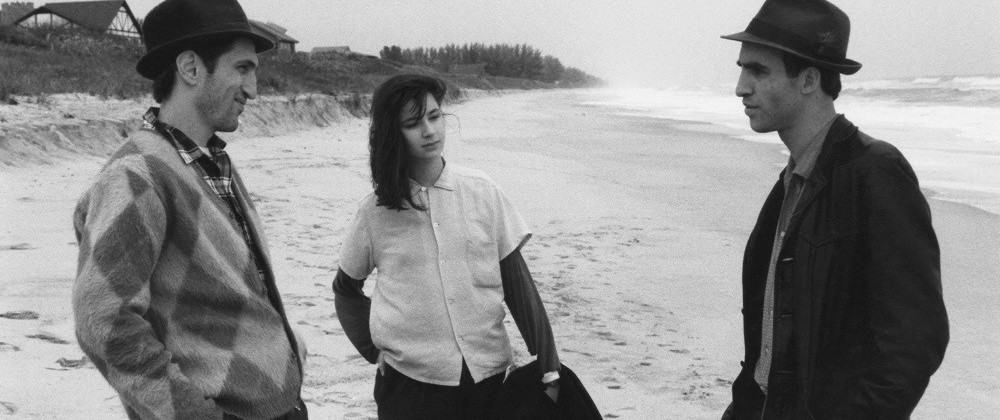
There has always been an independent cinema that more or less shadowed the mainstream film industry; and by the time of the American Great Depression, seven major studios made up the Hollywood industrial film complex. The major studios were involved in making feature length films or A-movies, including certain kind of B-movies. But there was another group of filmmakers that soon appeared in parallel competition with the contracted directors of the majors. These independent filmmakers set their efforts on marginally topical areas of cinematic production which included sex exploitation films, ethnic films dealing with racially charged issues (e.g. Black “African American” cinema), and some poverty row horror films produced by some lesser known B-studios (i.e. below the ranking of the minor studios) that exploited the double bill during the 1930s. In the late 1940’s and early 1950s, Orson Welles’ rebellious attitudes and unorthodox views of cinema came to exemplify the parallel activities of many independent filmmakers after WWII (e.g. actor-producers such as Burt Lancaster and Kirk Douglas), starting with his films that came after The Lady from Shanghai (1948), as with the case of Othello (1952). In the 1950s, United Artists, a company originally formed in 1919 by David Griffith, Charlie Chaplin, Mary Pickford, and Douglas Fairbanks, can be considered as a progenitor of the independent film production company since it did not own any physical studio property. Regional filmmaking also becomes another characteristic of 1960s independent cinema as typified by George Romero’s Night of the Living Dead (1968) which was made in Pittsburg, Pennsylvania. But most of all, it was John Cassavetes’ Shadows (1959) which conveys an illusion of being a record of real people, a film made on an extremely small budget, which encouraged other filmmakers to venture into the independent film production business.
In the late 1960s and 1970s, the first generation film school directors appear in the figures of Martin Scorsese (NYU), Francis Ford Coppola (UCLA), and George Lucas (USC), just to name a few. These maverick American filmmakers collaborate with the major studios to help them make their independent productions, the exception to this trend is Dennis Hopper’s Easy Rider (1969) which was made completely independent of the studios for a modest cost of $300,000.
Jim Jarmusch is a second generation film school director who began his career as an independent filmmaker in the early 1980s. Film historians believe that the new American independent cinema initially appears with Jarmusch’s Stranger Than Paradise (1984), but as mentioned above, independent cinema did not start in the 1980s. What defines the new American independent film industry in the 1980s is the appearance of the Sundance screenwriting workshops, and later the Sundance Film Festival; where young startup directors (including women and ethnic minorities) have the chance of showing their work to the public and film community. The screenings solely focus on films that have been produced with no interference from outside agencies and total control of the creative process including subject matters is completely left to the discretion of the filmmakers.
Stranger Than Paradise is the second feature made by Jarmusch. His first feature film is Permanent Vacation) (1980), which follows the wanderings of a young drop out, Aloysius, over a time span of 2 ½ days, representing a 77 minute preamble about drifting. Both films were photographed by the now renown independent director, Tom DiCillo. Stranger is a film with a neorealist look to it and a sense of humor, akin to a black “noir” comedy. Some critics classify it as a cross between Yasujiro Ozu and the Honeymooners TV show. But clearly, Stranger is a captivating film with a distinct American sensibility, starring a cast of three misfits; Bela ‘Willie’ Molnar played by John Lurie, Eva acted out by Eszter Balint and Eddie performed by Richard Edson.
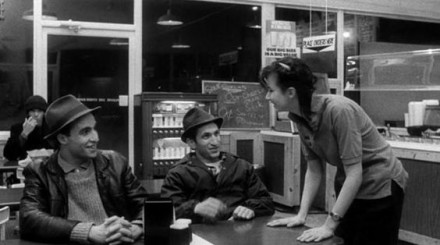
Willie, Eddie and Eva share a rare laugh
Stranger Than Paradise is a film that originates from two different financial situations. It first begins as a 10 minute silent film to be made with forty minutes of raw footage from Wim Wenders’ The State of Things (1982) but eventually grows to a 30 minute short film. Secondly, Jarmusch’s initial effort with Stranger Than Paradise catches the attention of the German TV producer, Otto Grokenberger, and the director, Paul Bartel, from Wender’s Gray City Productions. Thus, the remaining 60 minute segments of Stranger Than Paradise are made for the sum of $120,000 which is arranged by Grokenberger who becomes the film’s executive producer. It took nineteen days to shoot the film, spread out over a period of 2 years.
Stranger Than Paradise is a unique minimalist accomplishment constructed in three parts. Part I is an opening vignette entitled “The New World,” where a young Hungarian girl, Eva, arrives at her cousin Willie’s New York Lower East Side apartment, on her way to stay with her aunt Lottie, in Cleveland, Ohio. Part II, titled “One Year Later,” follows Willie and his best friend Eddie on their way to Cleveland where they visit Eva who is living a dreary existence. Part III is the final episode, entitled “Paradise,” where the two boorish hipsters and the cute emigre girl leave Cleveland on a trip to Florida, in a desperate effort to escape their perpetual boredom.
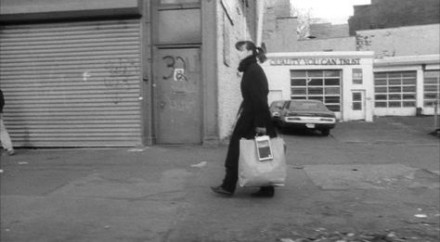
Eva Arriving
Stranger Than Paradise’s uniqueness comes from its reworking of the American landscapes through the brilliant cinematography of Tom DiCillo. The film is shot with a grainy black-and-white 35mm stock in a forced perspective akin to the style of photography of Robert Frank, where it records the stark images of this New World reality, an American Dream with the no fizz removed, and the persistent malaise of its individual characters living through the daily dredges of their uninteresting existence. In effect, Jarmusch reworks the image of the American landscape while exceeding the bounds of a story of alienation; and in so doing, he achieves a unique look at the decline of American living standards. His narrative strategy is based on the “road film” –e.g. Dennis Hopper’s Easy Rider (1969) and Francis Coppola’s The Rain People (1969)– but a modified one which depicts the journey through life as an endless road where everything is the same. The New World (as opposed to the Old World in Budapest, Hungary, a place that can be imaged in color) is depicted as a black-&-white vision that becomes a metaphor for a big cosmic joke played on three pathetic characters; the result is a comedy “noir” with serious deadpan humor blended with an art film look.
Stranger Than Paradise is shot in an ascetic formal style eschewing Hollywood illusionism. It reflects some stylistic influences from Wim Wenders’ Ozu-like camera placement and Robert Bresson’s sparse style. Jarmusch’s second feature is developed from a long take style and distancing aesthetics, imbued with shots that call attention to themselves through their excessive stylization, slow pacing and lack of movement, making the spectator more likely to become aware of themselves as a viewer; even the landscapes call attention to themselves through the use of particular terrain and specific places. Stranger Than Paradise depicts a bleak post-industrial image of America that reverses the stereotypical view of a gray and depressing Eastern Europe onto the idealized bright and cheerful American promised land. It paints America as depressingly mundane through a process of observation rather than making a political statement. Even though, the film is non-illusionist in form; it is structured impressionistically through a lyrical method of evocative vignettes that are very much like tableaux vivant. There are no plotted scenes in the conventional sense of the word nor dramatic development to points of climaxes. There are no dramatic close-ups nor reaction shots. There are no over-the-shoulder shots nor any cinematographic imagery that manipulates the viewer’s response; the cinematic language is imprecise or non-exact in conventional terms. In effect, it is an experimentally structured film that remains comprehensible because its form fits the story and its humor connects with the audience. Stranger Than Paradise’s vignettes are visually subversive analogues of sadly detached, apparently expressionless comedic one-liners.
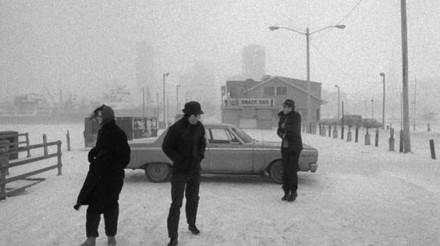
White Cleveland
Stranger Than Paradise is a repressed film with authentic American style acting depicting people who live in the margins of society, outside its normal structures, and its characters represent a real social grouping of denizen who have always existed throughout history. The emotional interrelationships of its characters are aloft and only sexually suggestive because they never really touch. The film truly expresses a state of being as opposed to a state of mind or of the heart. While Cassavetes’ Shadows is an expression of artistic frustration in response to Hollywood’s refusal to make films with real subjects; Coppola, Altman and Scorsese have to deal with the whole weight of film history, the traditions of past generations and the problem of creating film within their own generation (i.e. within a context when it seems that everything has been done).
Since Jarmusch is of the second film school generation, he is aware of the extensiveness of film history; and from his experience with viewing numerous films of differing genres and varied styles, he realizes the need to make “personal” films. Jarmusch does not discover a new cinematic language but instead, he finds his own voice by reworking several genres (e.g. road film + comedy “noir”) with different sensibilities that include the look of an art film and the feel of North American culture. In Stranger Than Paradise, the three misfits are like the three selves of the young director’s inner being. They are all outsiders with respect to the greater world at large (i.e. Willie, Eddie and Eva are outsiders with respect to their adopted country and Jarmusch is an outsider with respect to the mainstream cinema). Moreover, the film’s characters remain more or less outsiders with respect to themselves as the film’s ending attests. Besides its non-conventional episodic structure and stylized use of black leader in-between its segments, the film is characterized by its specificity with the mundanity of ordinary things; and throughout the film, the characters seem to wander about in a world that appears to them as all the same. For this reason, Strange Than Paradise is a film characterized as being “mundivagant.”
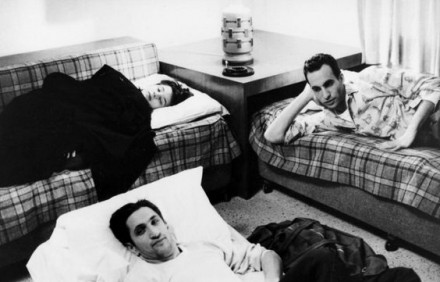
Three’s a crown anyone?
Hence, Jarmusch does not need to put his characters in dramatic situations since his aesthetic decision is a stylized realism where the characters simply occupy space in which they interact with each other on a purely superficial level, expressing their feelings through the mundane. Furthermore, the deadpan humor of this road movie also satirizes the aimlessness of a lost generation where it is a full time job to have no ambition in a world in which nothing seems to happen.
If the film’s narrative structure is dubiously connected to the ordinary pursuits of life, Willie and Eddie do not invest their day-to-day schedules nor structure their whole lives around the pursuit of money. They get it only when they need it. Hence, one of the minor themes is the way money works for these unambitious outsiders. The characterization of these two unemployed hipsters represents a disparaging disconnect to the idealized standards of the American way of life. In fact, the issues of identity and language create narrative conflict that impregnates the thematics of the story. The film alludes to the struggles of people who come to America, the pressures of integration into the great melting pot, and the effects of cultural transformations of each successive generation growing up in America.
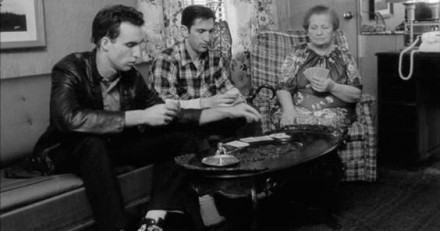
Hilarious aunt Lotte
Jarmusch does not follow the conventional rules of narrative structure since he drains the film of nearly all drama. His de-dramatization leaves the film with the splendors of a naked realism and the non-slick look of a student movie. He uses a minimalist visual style underplayed due to the inexperienced actors in which characterization is exteriorized –as opposed to being interiorized, i.e. there is no real emotional contact between them since they rarely ever touch, and expressed physically (e.g. driving a car, playing cards). Jarmusch bring the world into frame, both visually and aurally, by capturing the ordinary things of life in a very controlled manner. He does so by putting weight on cinematic elements that usually do not have any weight, such as on location sounds or loud overplayed music on a tape recorder (e.g. screaming Jay Hawkins’ “You’ve got a spell on me”). Thus, the maximal aural quality of the film-sound in Stranger Than Paradise creates a different emphasis on everyday reality by acknowledging that it is a physical universe, a concretized movie with an ironically cinematic approach; and in effect, Jarmusch’s America is not so much about something that is seen but also about something that is heard.
Tom DiCillo’s cinematography is strongly evocative and precisely done because it is reminiscent of the photography of Robert Frank, the pioneer of “snapshot aesthetics” in which the documentary image is rendered bluntly and without conscious artistry. DiCillo’s wide angle lens camera is mostly fixed and the scenes are commonly long single takes suffused with conversational silences and punctuated with environmental noises; all of which attract attention to generally unimportant details of the mise-en-scene.
Stranger Than Paradise (1984) is not a movie imbued with the spirit of the poststructuralist theories of signs nor with the collage-like fragmentary narratives of the 1970s “New Talkies” since it is not interested in psychoanalysis, semiotics or feminism. Stranger Than Paradise ¬is categorized by the critics as a “no-wave” film that falls within a relatively recent domain of cinema known as “New Character Studies” in which language and dialogue are emphasized and not taken for granted, as is the case with “The New Talkies,” while the psychological aspects of Continental drama such as self-understanding and complex rationalization of human nature are debunked from their previously privileged status. The film’s dialogue informs the audience about the characters’ habits, behaviors and perceptions since their conversational habits are marked by certain idiosyncrasies such as vocal tonality, word inflection, parochial subject matters, etc., indicating that talk is behavior and this talk forms the basis for the viewer’s inferences about the state of being of the characters. As mentioned above, Stranger Than Paradise deals with a community of outsiders set inside the boundaries (like a photo) of a pessimistic road picture. It is drained of romanticism and calls attention to details of a New World that appears to be out-of-kilter. The characters are socially disconnected and their situations and interactions are anomic; but strangely, their sense of awareness of these human anomalies (relative to the ideal American standards) seems to be absent. As suggested earlier, language and its delivery are the signs that build up the patterns of expectations and the body of inferences to which the spectator presumes about the characters’ personal identities and the degree of commitments to their mutual obligations toward the society and to each other. There are no permanent sets of obligations in their lives; instead companionship is a mutually convenient need until comfort can be achieved through other avenues. The audience comes to view them as nearly self-isolated, mundivagant gamblers that avoid boredom when money is around. Stranger Than Paradise is a film of many differences which make no difference because everything is always the same everywhere. It is a human story of individual outsiders who cannot break from inside themselves, in order to truly socially bond and hopefully emotionally form permanent relationships. Stranger Than Paradise is a film of bonding with the subsequent necessity of immediate unbonding; because after all, Jarmusch created the characterizations through a series of cinematic metaphors to represent the contemporary malaise infecting portions of our post-industrial society and of its declining living standards.
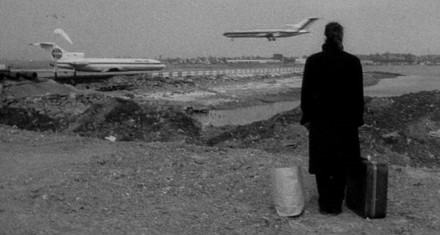
The desire to leave, thwarted



